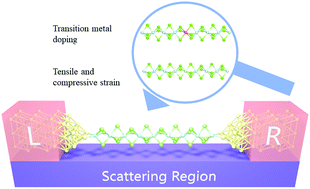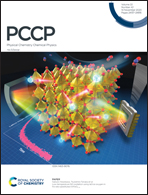Enhanced robustness of half-metallicity in VBr3 nanowires by strains and transition metal doping†
Abstract
The study of half-metallic behavior for transition metal tribromide nanowires is of great significance to the basic research and application in spintronics. We have theoretically investigated the spin transport properties of half-metallic VBr3 nanowires sandwiched between Au(100) electrodes. For the VBr3 nanowire with a length of 24.75 Å, the spin-filter efficiency (SFE) achieves 100% when the applied bias is less than 0.4 V. The robustness of half-metallic behavior in VBr3 nanowires is investigated by strains and transition metal doping. The bias range of VBr3 nanowires exhibiting perfect SFE is extended by tensile strains, while it becomes narrower under compressive strains. For VBr3 nanowires doped with Co and Cr, the bias range with ideal SFE is significantly broadened at a low doping concentration. In particular, the VBr3 nanowire doped with 1 Cr atom exhibits perfect SFE in an extremely wide bias range of 0–1.0 V. Our results show that the robustness of half-metallicity of VBr3 nanowires can be improved by tensile strains or certain doping, which provides promising ways for further design of high-performance spintronic devices.



 Please wait while we load your content...
Please wait while we load your content...